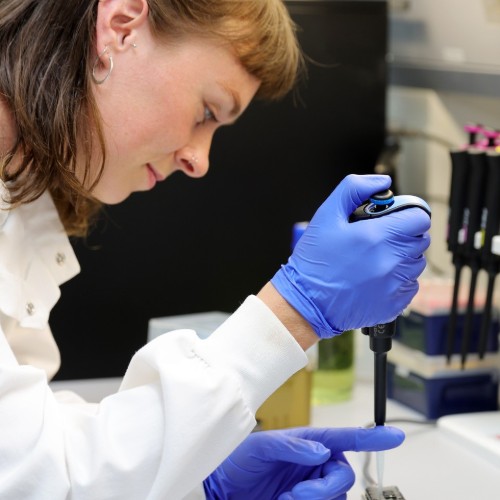
Lucia Nikolaeva-Reynolds performing targeted DNA sequencing to uncover the diversity of organisms present in a microbial community.Edward Gorochowski
Pioneering research has repurposed a gene editing tool to help shed light on the true biodiversity present in natural environments.
The study, led by the University of Bristol and published in the journal Royal Society Open Science, could help pave the way for more productive soils and improved health.
Microscopic organisms play a key role in the function of all ecosystems, from the cycling of nutrients in soils to the protection of the human gut. But characterising the wide array of species present within these environments is hugely challenging, with most methods only capturing a small fragment of what is actually there.
First author Lucia Nikolaeva-Reynolds, a Biology graduate from the University of Bristol, said: "Microbes rule the world. Although they are invisible to us, they are found virtually everywhere and play crucial roles throughout nature. Unfortunately, current technologies for monitoring microbes are limited to observing only a small fraction of those present. This leads to gaps in our knowledge about how this hidden microbial world supports the health of ecosystems."
The team of biologists overcame this issue by repurposing CRISPR – a revolutionary gene-editing tool – to gain a fuller picture, using it to extract long DNA 'barcodes' that could more accurately identify the microbes present within a sample.
Lucia explained: "By capturing long DNA signatures that are unique to each type of microbe and reading these using DNA sequencing, we can provide a clearer picture of the communities present, giving biologists a more complete picture of these intricate microbial worlds."
This advance is even more remarkable given that it arose from Lucia's final year undergraduate project, which involved initially testing of the approach. Following this, the Liv Sidse Jansen Memorial Foundation then provided a grant for Lucia to complete a summer internship and push the research towards a fully-fledged methodology.
Co-author Christopher Cammies, Biological Sciences Teaching Associate at the University of Bristol, added: "None of this would have been possible without the support of the foundation, which helps to progress a whole range of environmentally focused research and allows us to take early ideas and findings through to wider impact."
Senior author Prof Thomas Gorochowski, Professor of Biological Engineering and a Royal Society Research Fellow at the University of Bristol, said: "It is not every day that an undergraduate project leads to an exciting new experimental method. The combination of a bright and driven student who is passionate about environmental research, mixed with the collaborative research culture within the School of Biological Sciences and wider support by the Liv Sidse Jansen Memorial Foundation, made it all possible. I cannot wait to see how this research further expands our understanding of the role microbial communities play in nature."
The study, primarily funded by the Liv Sidse Jansen Memorial Foundation, was also supported by the Royal Society, Biotechnology and Biological Sciences Research Council (BBSRC), Engineering and Physical Sciences Research Council (EPSRC), and the teaching labs at the University's School of Biological Sciences.
Paper
'Cas9-based enrichment for targeted long-read metabarcoding' by L. Nikolaeva-Reynolds, C. Cammies, R. Chrichton and T.E. Gorochowski in Royal Society Open Science






